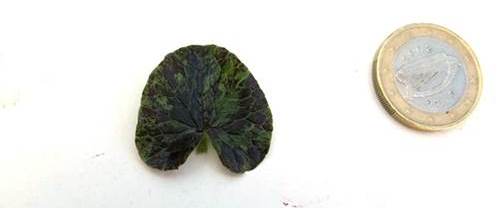Lesser Celandine
There is a Flower, the Lesser Celandine,
That shrinks, like many more, from cold and rain;
And, the first moment that the sun may shine,
Bright as the sun himself, ’tis out again!’
From “The Small Celandine” by William Wordsworth (1770-1850)
Overview
Like William Wordsworth all those years ago, in early spring we can enjoy the flowers of that common plant, the lesser celandine. However, before the flowers appear, there are the leaves, and I like to start by sharing some photographs of the emerging leaves of the lesser celandine, or more formally Ficaria verna (previously known as Ranunculus ficaria).
My fascination with this little plant is the delightful diversity of patterns on these small, shiny, heart shaped leaves. Here I am sharing a taster of some of the wonderful patterns of leaf colouration. Most of the varieties have accumulated over the years in my garden, where I took pictures using my CANON powershot. I have happily, and somewhat loosely, used the term “variety” to describe what are essentially “colour forms” of plants collected in the wild.
“Regular”
The bulk of the lesser celandines here in Ireland look (fittingly) rather green. A simple shiny green leaf, and that is it! As you can see from the pictures “Regular” is still slightly irregular by having a faint pattern of lighter and darker green. Many lesser celandine plants lack even this, and are homogeneously green in colour.

“Spokes”
“Spokes” is a very vigorous variety that displays a pronounced pattern of almost black lines that emerge from the base of the leaf in a radial pattern. Irrespective of whether the plant is flowering, a clump of these leaves makes a real impact, particularly in those gloomy late winter days.

“One-liner”
Variety “One-liner” does what it says on the tin. The leaf displays one clear black line, starting at the base of the leaf, and running straight through the middle towards the top, dividing the leaf in two equal halves. Moreover, the rest of the leaf appears to be relatively pale, making this a rather eye-catching variety. Another pretty vigorous variety, so I presume that the pale appearance is not due to a lack of chlorophyll and photosynthetic activity. I guess this calls for some scientific measurements!

“Ink-spot”
Now, if the lesser celandines have had a bad press for invasiveness (they are an invasive alien species in North America, where they are known as Fig Buttercup), this does not apply to variety “Ink-spot” in Ireland. This is a slow growing variety that I need to nurture, or I will lose it. Unlike “Spokes” and “One-liner” the dark colours in the leaf of this variety spread out in fine lines, which diffuse into a somewhat amorphous area in the centre of the leaf. Leaves remain small as well, which doesn’t help in getting a good image.

“Coffee-dregs”
Another slow growing variety. A pattern of dark lines, emerging from the base of the leaf, is complemented by a lighter, reddish-brown colouration that fills the space in between the spokes. Quite a dark plant which is sometimes rather difficult to see against a background of fallen (and sodden) tree leaves on the ground.

“Messy”
Not yet sure about this one, which appeared only this year. While all the previous varieties have been coming back year after year, this variety with its rather random black colouration is a new one. I will report back in due course to let you know whether it is stable!

‘Brazen Hussy’
Just to wrap this up, a picture of a “real” horticultural lesser celandine variety, ‘Brazen Hussy’. This variety displays lovely chocolate brown / black shiny leaves, against which the yellow flowers contrast very nicely. It might be a parent of the aforementioned “Messy”, although it is rather unlikely to have been an ancestor for any of the other varieties. In fact, I believe that ‘Brazen Hussy’ is a wild variety itself, found by the late, great plants-man Christopher Lloyd in the woods near his home.

So there you have it, a fantastic display of biodiversity within a single species. It is this type of genetic diversity within species that plays a key role in the adaptation of plants to changing climates. So, seemingly trivial variations in leaf colouration within a species reveal an underlying genetic treasure trove. Now, the really interesting question is of course what the functional role is of all these colour variations in leaves. Now that is a good question..! However, while we have extensive understanding of the functional role of the colour patterns of flowers, and how these relate to pollination, the story of leaf colour patterns remains largely unknown.
